These gentle root crops are liked by everyone who has tried them. Their advantage is not only great taste, but also great benefits for the body: they are deprived of rare oils and suitable for almost everyone. This vegetable cleanses the liver and kidneys, is able to dissolve stones in them. It serves as a valuable source of vitamin C, potassium and calcium. And this with a calorie content of only 21 kcal per 100 g of product! Even a novice gardener will cope with the cultivation of a daikon and caring for it in the open ground.
Material Content:
Growing daikon seedlings from seeds
Usually, a daikon is planted in the second half of summer. If you want to get a vegetable in late spring or early summer, you will first have to grow seedlings.
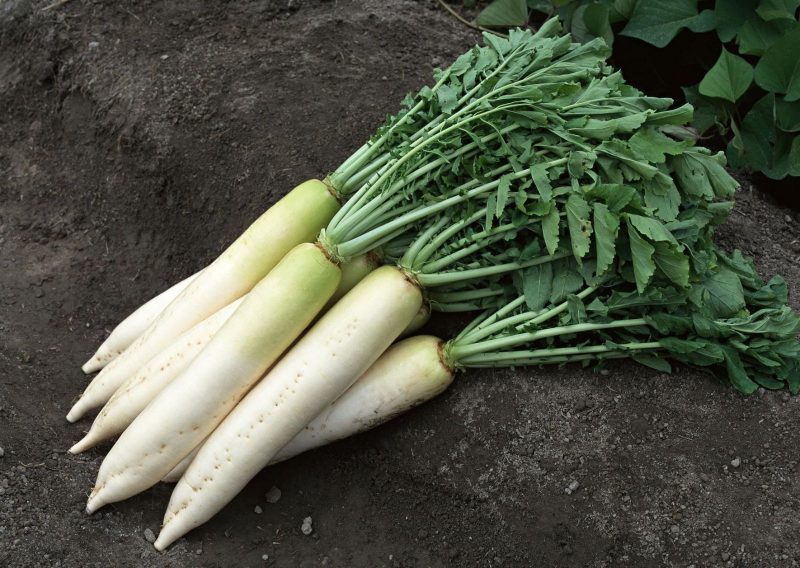
For seedlings, not all varieties are suitable, but only those that produce a root crop of small size and round or oval shape. When sowing seedlings for spring cultivation, preference should be given to varieties least prone to flowering. Timing depends on weather conditions and the region of cultivation. Most often, daikon radish is sown in late March or early April, for the southern regions this period is shifted to early March. When sown in soil, daikon seeds can germinate when the soil is warmed up to 5 degrees Celsius, adult plants tolerate even small frosts, but with seedlings grown in a room it is better not to risk it and plant it in warm soil.
Algorithm for growing daikon seedlings:
- seed preparation consists of heating them in water with a temperature of about 50 degrees for 20 minutes, further immediate cooling in cold water and holding in the refrigerator for about a day;
- sowing is carried out in separate containers or boxes, the height of the container for sowing should be at least 10 cm;
- the soil will need loose, well-permeable air and retain moisture;
- sow seeds to a depth of 2 cm in moist soil;
- until the shoots appear, the containers are kept in a warm place, covered with glass or film;
- as soon as the seedlings hatch, and this can happen already on the 5th day, they are transferred to a light, cool window sill;
- if the crops are too thick, the seedlings are thinned out when two real leaves are formed, at the same time they are fed with a solution of complete mineral fertilizer of a weak concentration;
- seedlings do not need picking, but watering should be timely, since the daikon loves moisture;
- seedlings can be relocated to the soil at the stage of formation of 2-4 true leaves, after hardening it in the open air for 2 weeks.
Outdoor landing
It is carried out when the soil warms up, and the air temperature exceeds the mark of 10 degrees Celsius.
Soil preparation and location
Japanese radish is an unpretentious culture, but without full coverage of the garden all day long it will yield only a crop of leaves and root crops similar to mouse tails. To get weighty vegetables, choose a site with light soil, it is better if it is sandy loam or loam. On clay soil, you can also grow a good crop of root crops, but the varieties should be designed specifically for growing in heavy soil.
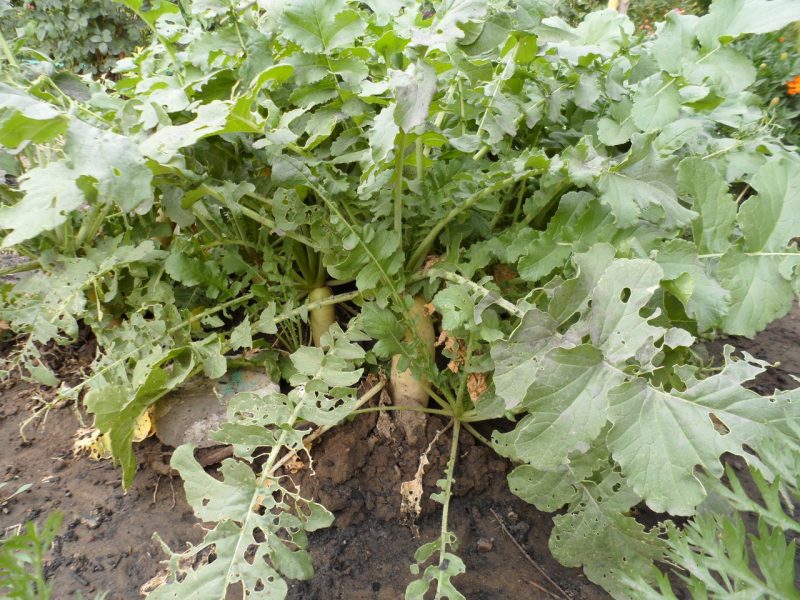
You can do the following: make holes with a round thick stick or a drill to a depth of 0.5 m and fill them with humus, and then sow the seeds.
The soil for spring planting is prepared in the fall, for summer it can be prepared after harvesting the main crop. A site is selected where vegetables from the cruciferous family have not been grown for 2-3 years to prevent possible diseases. Daikon loves loose soil, the root crop grows to the entire depth of the cultivated soil, and in some varieties their length can reach 60 cm.
Experienced gardeners recommend removing a layer of soil from a bed on a bayonet shovel and set it aside. The underlying layer is well loosened with a pitchfork, adding humus and returning the deposited soil to its place. From organic fertilizers, humus or well-rotted compost is introduced into the garden - near a bucket per square meter. m. Fresh manure is permissible to make under the previous culture. Of the mineral fertilizers, Japanese radish needs superphosphate in an amount of up to 50 g per square meter. and 20 g of potassium salt in the same area.
For a daikon, like all plants from the cabbage family, the acidity of the soil is very important. The soil reaction should be normal or slightly alkaline. Acidic soils must be liming. They do this in the fall, not combining with the introduction of organic fertilizers, so that there is no loss of nitrogen. Adding 2 glasses of ash per square meter also helps to combat soil acidity. m beds. By slightly alkalizing the soil, it will serve as a source of potassium and phosphorus salts available to plants, as well as a large number of necessary trace elements.
Selection of planting material
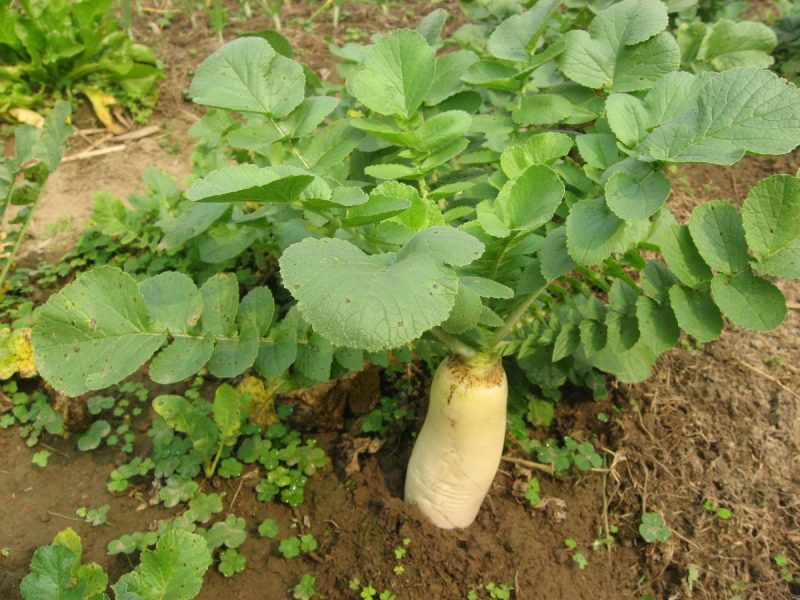
There are many varieties of daikon, both domestic and native to Japan. Their choice depends on whether you are going to store daikon or immediately eat it. When appropriate conditions are created, some varieties can be stored for up to six months. In the middle lane, a good crop can only be obtained by sowing early and mid-ripening varieties. Late ripening - just do not have time to form a large crop. For loose light soils, daikon varieties with any root size are suitable, on heavy dense soils it is better to take those that give a small oval or round vegetable.
How and when to plant
This unpretentious vegetable has a feature that gardeners sometimes forget about: it is a plant of long daylight hours. If the duration of the light period is more than 13 hours, the plant forms not root crops, but generative organs: a flower arrow, and then seeds.Wrong sowing time is the main reason for the failure in the cultivation of this valuable root crop.
As a rule, daikon is sown in the ground in the second half of summer. It is better to do this in the 2-3 decades of July, and early ripening varieties in early August.
By this time, some vegetables are already finishing vegetation and are removed from the beds: winter garlic, onion turnip. In their place, the daikon will be very good.
To form a full-fledged crop, Japanese radish needs a large area of nutrition. The planting pattern for varieties with small and medium root crops is 30x50 cm. Large-fruited varieties are sown according to the 40x50 cm pattern; for varieties with long root crops of small diameter, the row spacing can be made smaller - 40 cm.
Usually 2-3 seeds are sown in one hole to a depth of about 2 cm. The soil should be moist. Extra plants after germination need to be carefully trimmed, if they do not sit close to each other, they can be transplanted. By the way, young daikon leaves are very good in salads. To get seedlings faster, seeds are prepared in the same way as for sowing for seedlings, and the bed itself is covered with non-woven material. The same thing happens when planting seedlings, but the soil around the plants must be mulched with a layer of hay, straw, dried grass without seeds.
Planting dates for the winter
A close relative of daikon - radish has been sown for a long time in the winter. The result is an early harvest of strong and strong plants. Can be sown before winter and daikon. It will yield in spring without growing seedlings. For sowing, only precocious varieties that are not inclined to shoot are selected, the rest will bloom with the onset of spring heat. The exact timing of winter sowing is determined by the weather, since it is carried out after steady frosts in frozen ground. The beds for it are prepared in warm time, by harvesting dry soil or humus to sprinkle seeds. They are best kept indoors. The bed should be completely ready for sowing: it is dug up, fertilized, rows are outlined.

With the onset of frost, sowing is carried out with a double amount of seeds against the usual norm. From above they are covered with harvested earth or humus.
They mulch the entire surface of the bed. In the spring, the mulch needs to be raked in the aisles, and the bed is covered with a film thrown over the arcs, so that the soil warms up faster.
Radish daikon: care
Daikon care is minimal. The main thing is to provide plants with nutrition and moisture.
Watering schedule
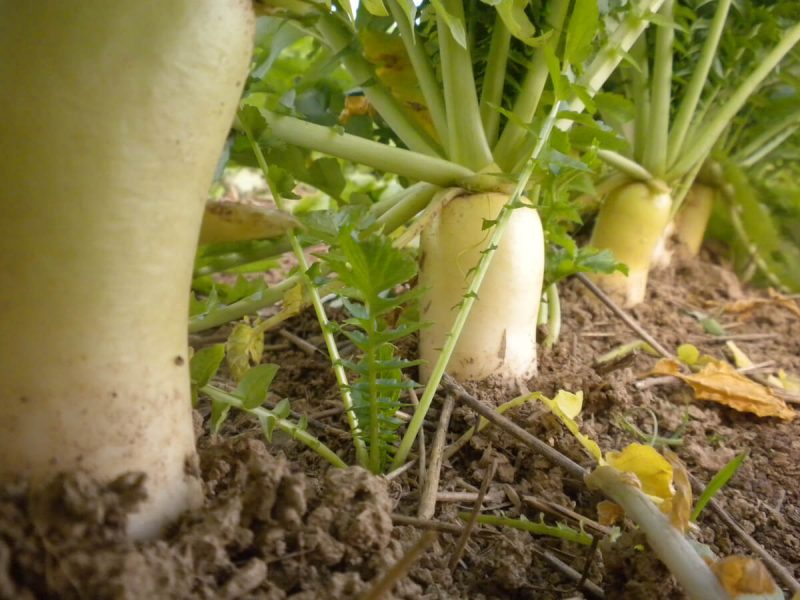
This sweet radish loves water. Therefore, watering is required regularly. In cool weather, plants can be watered every 5 days; in hot weather, watering is required more often. The soil should always be slightly moist. In a drought with a lack of moisture, the quality of root crops deteriorates, they become woody and lose their juiciness. After watering, the soil under the plants needs to be loosened shallow. It is good to mulch it with organic raw materials, it will not overheat and will retain moisture well. If the root crop protrudes above the surface of the soil, it needs to be spudded so that the upper part does not become coarse and bitter.
Fertilizer and fertilizer
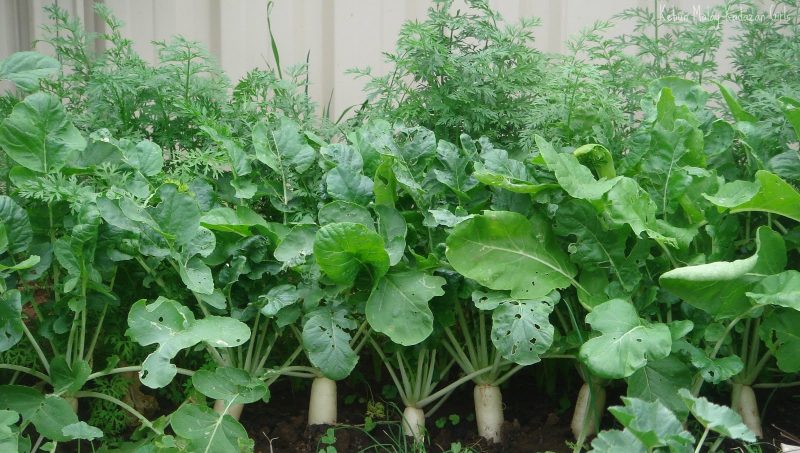
If the soil is fertile with a sufficient humus content, the plants will have enough nutrition that was laid in the preparation of the beds. On poor soils, additional fertilizing will be required. The first is done at the stage of formation of 3-4 leaves, sprinkling ash under the bushes and a pinch of full mineral fertilizer. If there is a need to accelerate the formation of the root crop, you can repeat top dressing again after 2-3 weeks.
Diseases and Pests
In daikon, they are the same as in all plants of the cruciferous family. Most diseases are the result of a violation of agricultural technology rules. If the soil is too wet, the daikon is susceptible to vascular and mucous bacteriosis. As a preventative measure, you need to properly prepare the seeds before sowing. In addition to the usual procedures, you can treat the seeds with the biological product Planriz, which is also used after planting the plants. All treatments are carried out strictly according to the instructions.
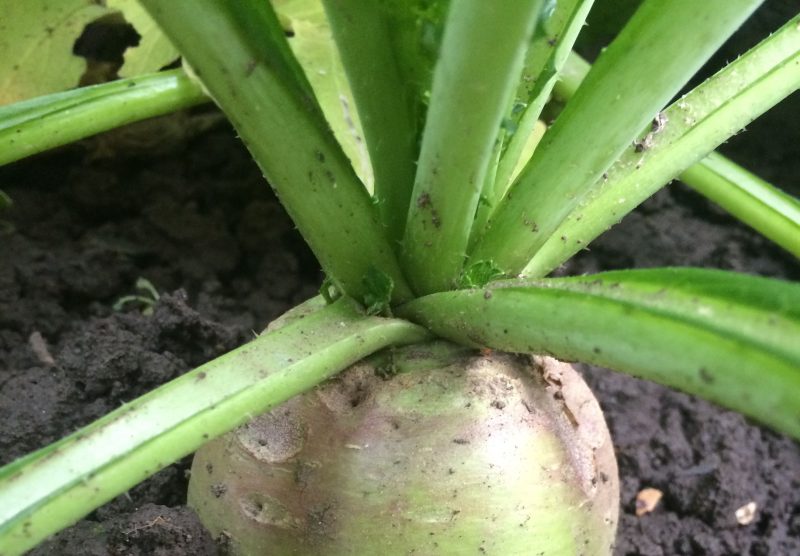
Of the pests, a cruciferous flea annoys young plants, and for adults - cabbage fly, garden scoop, cabbage whitewash. Against them, ash treatment on wet leaves, spraying with infusion of tobacco or hot pepper are effective. Marigolds can be planted between daikon, they scare away pests with their smell.
But the most radical way is to grow plants under nonwoven covering material throughout the growing season. The benefits of this are twofold: the conditions for the development of plants are better and it is difficult for pests to reach them.
Harvesting and storage
So that the grown root crops are well stored, they should be correctly collected. You need to do this before frost, in the middle lane - at the end of September. For harvesting, choose a sunny day. Daikon root crops are fragile and have a thin skin. Any damage to it is fraught with quick damage to the vegetable. Therefore, they dig up the daikon carefully, using a pitchfork. Dug vegetables are laid out on a bed for drying. After that, they can be washed and dried well in the shade for about 2 days. Leaves are cut, leaving a stump of 2 cm.
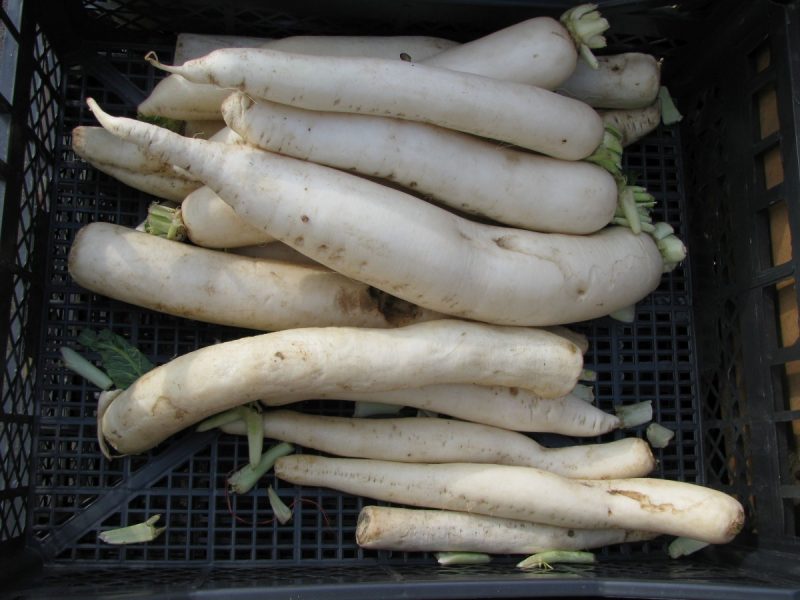
They store daikon in the same way as carrots - in boxes with slightly damp sand or in sawdust. Vegetables should not touch each other. Storage temperature - from 0 to 5 degrees heat. Freezing for a vegetable is fatal. You can save the crop in perforated bags, sprinkled with onion husks.
Varieties of radish daikon
In Japan, daikon crops occupy first place in area. The Japanese know a lot about proper nutrition. Therefore, they have about 400 daikon varieties. Our assortment is much more modest. Until recently, buying daikon seeds was a problem, but now the choice is wide enough.

Varieties of Japanese selection:
- varieties from the Minovase group - all of them are early ripening, resistant to heat and disease, the root crop is long - up to 55 cm with a diameter of up to 8 cm, ¼ part of it is above the soil level;
- varieties from the Miyashige group - have a cylindrical root crop up to half a meter long and up to 9 cm in diameter, it is submerged in the soil by ½ part;
- varieties from the Shogoin group are notable for the fact that root crops grow well on heavy soils, their diameter up to 20 cm;
- varieties from the Sirogari group - differ in the early stages of the formation of the root crop - only 55 days and its good size - in length up to 30 cm, and in diameter - up to 7 cm;
- varieties from the Nineigo group are resistant to flowering and frost, root crops up to 60 cm long, and up to 6 in diameter.
Domestic varieties of daikon:
- Sasha - has a small round root crop that ripens in 45 days;
- Elephant Fang - a late-ripening variety with root crops up to 22 cm long;
- Dubinushka is a medium-ripening variety with a huge root crop up to 4 kg in weight;
- Dragon - mid-season variety, grows to 1 kg;
- Flamingos - medium ripening with pink flesh, weight - up to 800 g.
Russian seed-growing complexes propagate seeds not only of domestic zoned varieties, but also of the "Japanese". For example, Minovashi daikon seeds can be bought in the shops of Gavrish, SEDEk, Aelita.
Daikon is a healthy and unpretentious vegetable. It should be in every garden.












